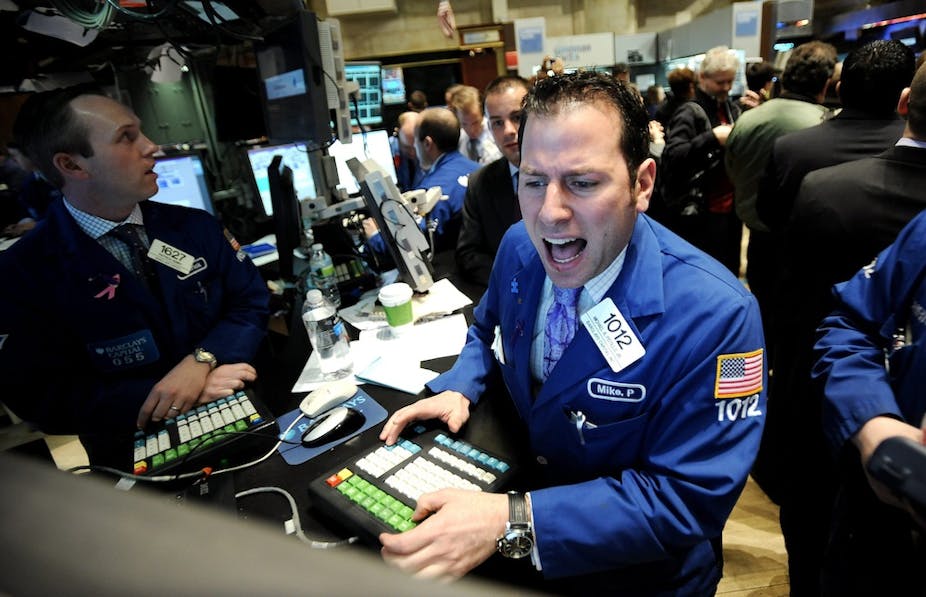Fred Tomczyk, a 20-year veteran of the financial services industry, has his finger on the pulse of investor sentiment: “ … the preference for cash that we’re seeing among new investors suggests a stronger risk aversion coming out of this downturn than we have seen in the past.” USA Today, November 1, 2010.
BROKERS like Tomczyk are well aware of the relevance of investor moods. When the market is surging investors will flock to it, expecting ever more unrealistic gains and allocating their portfolios accordingly. When the inevitable downturn follows, investors will turn increasingly pessimistic yet surprisingly hold on to their risky portfolios to avoid capitalising losses. When they finally reallocate their portfolios to low-risk cash investments, they subsequently refuse to respond to a market turnaround. Smart money should be able to exploit those biases by selling (buying) over (or under)valued risky assets. Yet, even smart money seems unable to go against the grain, as moods are often persistent and the eventual turnaround is always hard to predict. These two phenomena are known as cognitive biases and limits to arbitrage, which underpin the new discipline of behavioural finance.
Investors’ cognitive biases – such as over-confidence in their ability to forecast; using rules of thumb in investment allocation; using historical “anchors” as benchmarks; or alternatively, an excessive reliance on recent past performance – are well documented. Finance academics and commentators use these psychological traits to “explain” irrational anomalies such as herd behavior or speculative bubbles and crashes.
Unfortunately, it has not been straightforward to incorporate these irrational investor traits in standard rational-agent finance models to assist portfolio allocation, option pricing or the identification of arbitrage opportunities. After all, the typical investor’s behaviour is most likely a potpourri of psychological traits. Some combinations of cognitive biases reinforce a particular valuation error, other combinations are contradictory and may even lead to a valuation that is perfectly indistinguishable from the rational investor solution.

Furthermore, it is not at all clear whether or when a particular cognitive bias dominates among a heterogeneous and diverse set of investors, ranging from “mum and dad” investors to sophisticated institutional investors. It has been suggested that cognitive errors are more commonly made by less sophisticated retail investors, and are reflected in more obvious mispricing of small, relatively unknown and financially distressed stocks. Unfortunately, these are also the very stocks that are hardest to value accurately because of a lack of liquidity, highly speculative forecast earnings, and general lack of fundamental information. Attributing perceived mispricing to investor irrationality is therefore hardly robust science.
The behavioural finance literature, initiated by Nobel laureate Daniel Kahneman and Amos Tversky, proposes stylistic models that capture psychological behavioral traits. Based on plausible behavioural parameter values, these models can predict under-diversified portfolio allocations and various price distortions. These irrational financial outcomes are then compared and matched to real world portfolio allocations and mispricing by changing the behavioral parameters. This is a rather indirect and imprecise inference of behavioral biases.
Unfortunately, cognitive biases are not readily observed directly from investor behaviour. Investor surveys and carefully designed experiments have been used to “measure” behavioural parameters for risk aversion and various risk premia. While these techniques have merits to determine ballpark values, they are not particularly insightful if these values are in fact time-varying (reflecting investor mood swings). Surveys and experiments also seem to elicit behaviours from participants that are distinctly different from how they behave under real-life circumstances.

Hence, we have arrived at a crossroads. We all know that financial market participants are not always rational in their decision-making, yet our standard toolkit (equity and fixed-income pricing and allocation models, risk management models, derivatives pricing models) is not easily accommodated to account for this. The popular use of sentiment indices as an aggregate representation of investor mood in those models might seem attractive, but fails to provide a better understanding of the underlying dynamics in investor behavior.
A way forward is provided by the ready availability of traded option prices for pretty much every financial asset. Option prices for various strikes reflect the option trader’s assessment of a range of possible underlying asset values at expiration of the option. By comparing the option-implied (subjective) probabilities with observed (objective) probabilities of underlying asset values, we get instant insight in and quantification of the investors’ cognitive biases.
Recent derivatives research indicates that loss aversion (as opposed to traditional risk aversion, where gains and losses are considered symmetrically) and Kahneman and Tversky’s prospect theory (where unlikely outcomes are attributed unrealistically high likelihoods) are driving the well-known volatility smile in option prices, which occurs in a derivatives market where option prices reflect investors attaching too high probability to increasingly unlikely future returns.
More importantly, the intertemporal dynamics of option-implied cognitive biases will help forecast the extent and persistence of irrational behaviours. An ability to forecast investor behaviour could help overcome the limits to arbitrage and thus avoid costly bubbles and crashes.

